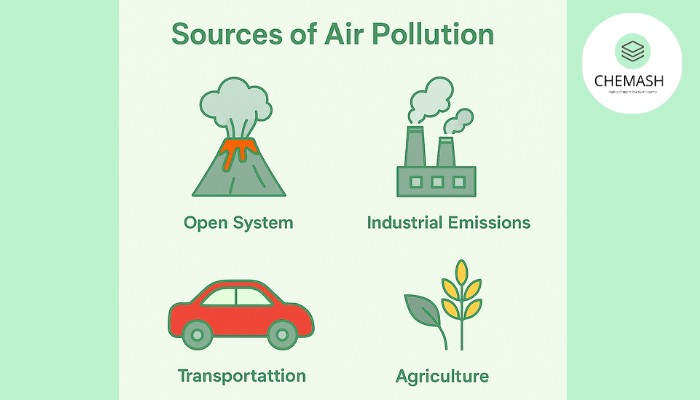
Sources of Air Pollution
Air pollution originates from various natural and human-made sources that introduce harmful substances into the atmosphere, affecting environmental and human health.
Natural Sources
Natural sources of air pollution release pollutants without human intervention. Some major contributors include:
- Volcanic Eruptions: Release ash, sulfur dioxide (SO₂), and carbon dioxide (CO₂).
- Forest Fires: Produce smoke, carbon monoxide (CO), and particulate matter.
- Dust Storms: Lift large amounts of dust and soil into the air.
- Sea Spray: Adds salt particles and aerosols.
- Biological Decay: Emits methane (CH₄) and other gases.
Anthropogenic (Human-made) Sources
Human activities are the primary contributors to air pollution. Major examples include:
- Industrial Emissions: Factories emit sulfur oxides (SOx), nitrogen oxides (NOx), and VOCs.
- Vehicle Exhaust: Cars release CO, NOx, hydrocarbons, and particulate matter.
- Burning of Fossil Fuels: Produces CO₂, SO₂, and pollutants.
- Agricultural Activities: Fertilizers and livestock release ammonia and methane.
- Waste Disposal: Burning waste generates toxic gases.
- Construction & Demolition: Creates dust and particulates.
Secondary Pollutants
Some pollutants form in the atmosphere via chemical reactions involving primary pollutants. Examples include:
- Ground-level Ozone (O₃): Created by NOx and VOCs reacting in sunlight.
- Smog: Combination of smoke and fog, often from vehicles and industry.
- Acid Rain: Forms when SO₂ and NOx react with water vapor.
Quiz – Sources of Air Pollution
- Which of the following is a natural source of air pollution?
a) Vehicle exhaust
b) Volcanic eruption
c) Industrial emissions
d) Agricultural activities
Answer: b)
Explanation: Volcanic eruptions release gases and ash naturally into the atmosphere. - What pollutant is primarily produced by vehicle exhaust?
a) Methane
b) Ammonia
c) Carbon monoxide
d) Sulfur dioxide
Answer: c)
Explanation: Carbon monoxide results from incomplete fuel combustion in engines. - Ground-level ozone is an example of:
a) Primary pollutant
b) Natural pollutant
c) Secondary pollutant
d) Particulate matter
Answer: c)
Explanation: It forms through reactions involving other pollutants and sunlight. - Which activity contributes to methane emissions?
a) Volcanic eruptions
b) Forest fires
c) Agricultural practices
d) Industrial manufacturing
Answer: c)
Explanation: Livestock and fertilizers release methane, a potent greenhouse gas.
Frequently Asked Questions (FAQs)
Q1. What are the main sources of air pollution?
A: Natural sources like volcanoes and forest fires, and human-made sources such as vehicles, industries, and agriculture.
Q2. What is a secondary pollutant?
A: A pollutant formed in the atmosphere from chemical reactions of primary pollutants — e.g., ozone, smog, acid rain.
Q3. How can air pollution be controlled?
A: Through emission control, cleaner fuels, green transportation, and promoting renewable energy sources. Up Next: Control Measures & Air Quality Index (AQI) | Learn more on Wikipedia
